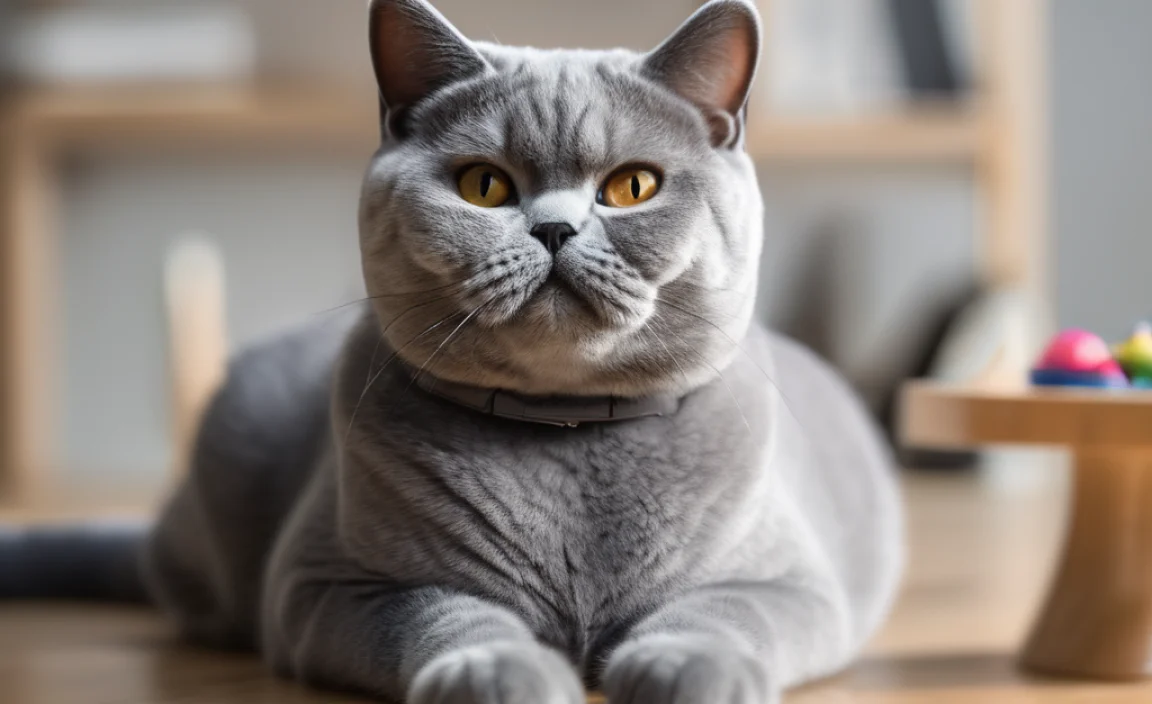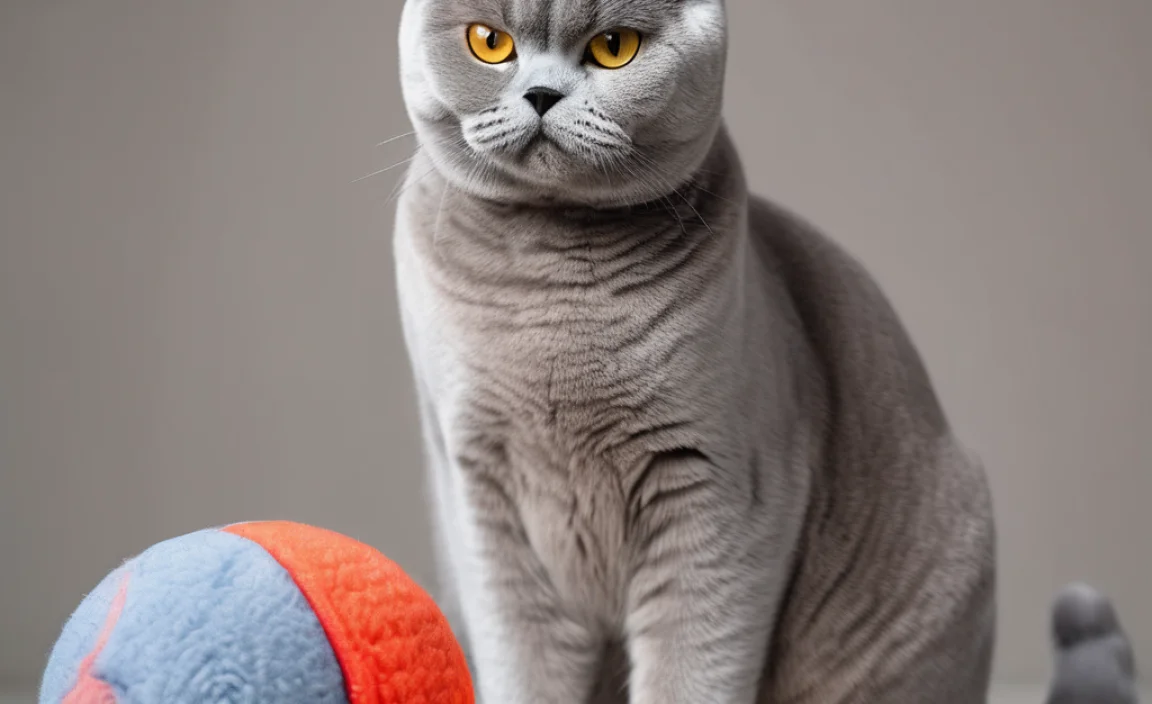British Shorthair Cat Engagement Toys: Ultimate Guide
**Quick Summary:** **British Shorthair cats need engaging toys to stay happy and healthy. Choose toys that encourage hunting, like puzzle feeders, wands with feathers, and toy mice. Rotate toys to keep your cat interested, and make sure they are safe and durable. Interactive play is key to preventing boredom and promoting exercise for your British Shorthair.**
Is your British Shorthair looking a little bored? Don’t worry, you’re not alone! These cats are known for their calm nature, but they still need plenty of fun and stimulation. Without enough to do, they might get into mischief or even become a little sad. The good news is that with the right toys, you can keep your furry friend happy, healthy, and entertained. Let’s explore the best ways to engage your British Shorthair with toys they’ll adore!
In this guide, I’ll walk you through everything you need to know about choosing the perfect engagement toys for your British Shorthair. We’ll cover different types of toys, how to keep things interesting, and how to make playtime safe and fun. Get ready to turn your home into a kitty playground!
Understanding Your British Shorthair’s Play Style

British Shorthairs are known for their gentle and relaxed personalities. However, like all cats, they have natural instincts to hunt, explore, and play. Understanding their play style is the first step in choosing the right engagement toys.
What Motivates a British Shorthair?
- Hunting Instincts: British Shorthairs love to stalk, chase, and pounce. Toys that mimic prey, such as toy mice or feather wands, are often a hit.
- Curiosity: These cats are naturally curious and enjoy exploring new things. Puzzle toys and interactive feeders can satisfy their curiosity and keep them mentally stimulated.
- Comfort: While they enjoy playing, British Shorthairs also appreciate comfort. Soft, plush toys can provide a sense of security and make playtime even more enjoyable.
Common Play Patterns
British Shorthairs typically exhibit these play patterns:
- Short Bursts of Energy: They may not play for hours on end, but they do enjoy short, intense play sessions.
- Independent Play: While they enjoy interactive play, they are also content to play on their own.
- Observational Play: Sometimes, they simply like to watch and observe before engaging in play.
Top Types of Engagement Toys for British Shorthairs

Now that we understand their play style, let’s look at the best types of toys to keep your British Shorthair engaged.
Interactive Toys
Interactive toys require your cat to actively participate, providing both physical and mental stimulation.
- Puzzle Feeders: These toys dispense food or treats when your cat solves a puzzle. They’re great for slowing down fast eaters and keeping your cat entertained.
- Laser Pointers: Cats love chasing the elusive red dot. Just be sure to end the session with a tangible toy to satisfy their hunting instincts.
- Wand Toys: These toys have a wand with feathers, ribbons, or other attachments that you can move around to mimic prey. British Shorthairs love to chase and pounce on these.
Solo Play Toys
Solo play toys allow your cat to entertain themselves, which is perfect for when you’re not available to play.
- Toy Mice: These classic toys are always a hit. Choose ones with different textures and fillings to keep things interesting.
- Crinkle Balls: The crinkling sound of these balls is irresistible to many cats. They love to bat them around and chase them.
- Catnip Toys: Catnip is a natural herb that many cats find irresistible. Toys filled with catnip can provide hours of entertainment. According to the Cornell Feline Health Center, about 50-75% of cats are affected by catnip.
Enrichment Toys
Enrichment toys provide environmental stimulation and encourage natural behaviors.
- Cat Trees: These provide a place for your cat to climb, scratch, and observe their surroundings.
- Scratching Posts: Scratching is a natural behavior for cats, and scratching posts give them a place to do it without damaging your furniture.
- Window Perches: British Shorthairs love to watch the world go by. A window perch gives them a comfortable spot to do so.
Toy Rotation
Cats can get bored with the same toys over and over. Toy rotation involves switching out your cat’s toys regularly to keep things fresh and exciting.
- Gather Your Cat’s Toys: Collect all of your cat’s toys and divide them into groups.
- Rotate the Toys: Put one group of toys out for your cat to play with, and store the others away.
- Switch Regularly: Every week or two, switch out the toys with a new group.
DIY Engagement Toys

You don’t have to spend a lot of money to keep your British Shorthair entertained. Here are some DIY toy ideas:
- Cardboard Box Castle: Cats love boxes! Cut holes in a cardboard box to create a fun and engaging playhouse.
- Sock Mouse: Fill an old sock with catnip and tie it off to create a simple and fun toy mouse.
- Toilet Paper Roll Puzzle: Cut holes in a toilet paper roll, fold in the ends, and fill it with treats. Your cat will have to work to get the treats out.
Safety First: Choosing Safe Toys

When choosing toys for your British Shorthair, safety should always be your top priority.
Potential Hazards to Avoid
- Small Parts: Avoid toys with small parts that your cat could swallow, such as buttons or beads.
- Strings and Ribbons: These can be dangerous if ingested. Always supervise your cat when they’re playing with toys that have strings or ribbons.
- Toxic Materials: Make sure the toys are made from non-toxic materials that are safe for your cat to chew on.
Materials to Look For
- Durable Fabrics: Choose toys made from durable fabrics that can withstand your cat’s claws and teeth.
- Natural Materials: Toys made from natural materials, such as wood or cotton, are often a safer choice.
- Non-Toxic Dyes: Make sure the toys are dyed with non-toxic dyes that won’t harm your cat if ingested.
Creating an Engaging Play Environment

In addition to choosing the right toys, it’s also important to create an engaging play environment for your British Shorthair.
Setting Up a Play Zone
- Designated Area: Create a designated play area with plenty of toys and activities.
- Vertical Space: Provide vertical space, such as cat trees or shelves, for your cat to climb and explore.
- Hiding Spots: Cats love to hide, so provide plenty of hiding spots, such as boxes or tunnels.
Incorporating Play into Daily Routine
- Scheduled Playtime: Set aside time each day for interactive play with your cat.
- Treat Rewards: Use treats to reward your cat for playing and engaging with the toys.
- Positive Reinforcement: Praise and encourage your cat when they play, to reinforce positive behavior.
Addressing Common Playtime Challenges
Even with the best toys and environment, you may encounter some challenges during playtime.
Dealing with a Bored Cat
If your cat seems bored, try these tips:
- Introduce New Toys: Rotate the toys regularly to keep things fresh and exciting.
- Change Playtime: Vary the type of play you engage in, such as chasing, pouncing, or puzzle-solving.
- Increase Interaction: Spend more time playing with your cat to provide them with the attention and stimulation they need.
Managing Destructive Behavior
If your cat is engaging in destructive behavior, such as scratching furniture, try these tips:
- Provide Alternatives: Give your cat plenty of scratching posts and toys to satisfy their natural instincts.
- Redirect Behavior: When you see your cat scratching furniture, redirect them to a scratching post.
- Make Furniture Unattractive: Use deterrents, such as double-sided tape or sprays, to make furniture less appealing to your cat.
Encouraging Reluctant Players
If your cat is reluctant to play, try these tips:
- Start Slowly: Begin with short, gentle play sessions and gradually increase the duration as your cat becomes more comfortable.
- Use Tempting Toys: Choose toys that are highly appealing to your cat, such as those with catnip or feathers.
- Be Patient: It may take time for your cat to warm up to playing, so be patient and persistent.
British Shorthair Engagement Toys: A Detailed Look
To provide a clearer picture, let’s examine some specific toy types and their benefits for British Shorthairs.
Puzzle Feeders
Puzzle feeders are designed to challenge your cat mentally while they eat. These toys require your cat to solve a puzzle to access their food, providing both entertainment and mental stimulation.
| Type of Puzzle Feeder | Description | Benefits | Considerations |
|---|---|---|---|
| Interactive Bowls | Bowls with obstacles that slow down eating. | Prevents gulping, aids digestion, provides mild mental stimulation. | May be too easy for some cats. |
| Treat Balls | Balls with holes that release treats as the cat rolls them. | Encourages activity, provides moderate mental stimulation. | Can be noisy on hard floors. |
| Puzzle Boards | Boards with various compartments and puzzles to solve. | High level of mental stimulation, keeps cats engaged for longer periods. | Requires cleaning, may be challenging for some cats. |
Wand Toys
Wand toys mimic the movement of prey, stimulating your British Shorthair’s hunting instincts. These toys typically consist of a wand with feathers, ribbons, or other attachments.
| Type of Wand Toy | Description | Benefits | Considerations |
|---|---|---|---|
| Feather Wands | Wands with feathers attached. | Highly stimulating, encourages chasing and pouncing. | Feathers can be fragile and need replacement. |
| Ribbon Wands | Wands with long ribbons attached. | Provides visual stimulation, good for interactive play. | Ribbons can be a choking hazard if ingested. |
| Telescopic Wands | Wands that can be extended for longer reach. | Allows for a wider range of movement, good for active play. | Can be more expensive than standard wands. |
Toy Mice
Toy mice are a classic cat toy that never goes out of style. They come in various sizes, textures, and materials, providing endless entertainment for your British Shorthair.
| Type of Toy Mouse | Description | Benefits | Considerations |
|---|---|---|---|
| Plush Mice | Soft, stuffed mice. | Comforting, good for cuddling and gentle play. | May not be as durable as other types. |
| Rattling Mice | Mice that make a rattling sound when moved. | Stimulates auditory senses, encourages chasing. | Can be noisy for some owners. |
| Catnip Mice | Mice filled with catnip. | Highly appealing to most cats, provides added stimulation. | Catnip scent may fade over time. |
Real-Life Examples: Success Stories
To illustrate the effectiveness of engagement toys, here are a few real-life examples of how they’ve helped British Shorthairs:
- Case Study 1: A British Shorthair named Winston was overweight and lacked energy. By introducing puzzle feeders and wand toys, his owner helped him lose weight and become more active.
- Case Study 2: A British Shorthair named Luna was anxious and destructive when left alone. By providing her with a cat tree and plenty of solo play toys, her owner reduced her anxiety and destructive behavior.
- Case Study 3: A British Shorthair named Oliver was uninterested in playing. By experimenting with different types of toys and play styles, his owner discovered that he loved chasing laser pointers and batting around crinkle balls.
Expert Advice: Tips from Feline Behaviorists
To further enhance your understanding of British Shorthair engagement, here are some tips from feline behaviorists:
- Start Early: Introduce toys and play to your British Shorthair kitten as early as possible to encourage healthy play habits.
- Be Consistent: Set aside time each day for interactive play to provide your cat with the attention and stimulation they need.
- Observe Your Cat: Pay attention to your cat’s preferences and adjust your play style and toy choices accordingly.
Resources for Further Learning
If you’re interested in learning more about British Shorthair engagement, here are some valuable resources:
- RSPCA: The RSPCA provides information on cat care and behavior.
- The International Cat Association (TICA): TICA offers resources on cat breeds and responsible cat ownership.
- Purina: Purina provides articles and tips on cat play and enrichment.
FAQ: Common Questions About British Shorthair Play
Here are some frequently asked questions about British Shorthair play and engagement:
1. How much playtime does a British Shorthair need?
British Shorthairs typically need about 15-30 minutes of playtime per day. This can be divided into shorter sessions throughout the day.
2. What are the best toys for a British Shorthair kitten?
Good choices for kittens include soft plush toys, small toy mice, and wand toys with feathers. Make sure the toys are safe and don’t have small parts that could be swallowed.
3. How can I tell if my British Shorthair is bored?
Signs of boredom include excessive sleeping, overeating, destructive behavior, and lack of interest in playing.
4. Is it okay to use a laser pointer with my British Shorthair?
Yes, but always end the session with a tangible toy so your cat can satisfy their hunting instincts.
5. How often should I rotate my cat’s toys?
Rotate your cat’s toys every week or two to keep things fresh and exciting.
6. Can I make my own cat toys?
Yes, DIY cat toys can be a fun and inexpensive way to keep your British Shorthair entertained. Just make sure the toys are safe and don’t contain any toxic materials.
7. What if my British Shorthair doesn’t like to play?
Some British Shorthairs are less playful than others. Try different types of toys and play styles to find what your cat enjoys. Be patient and persistent, and reward your cat when they engage in play.
Conclusion
Keeping your British Shorthair engaged with the right toys is essential for their physical and mental well-being. By understanding their play style, choosing safe and stimulating toys, and creating an engaging play environment, you can ensure that your furry friend stays happy, healthy, and entertained. Remember to rotate toys regularly, incorporate play into their daily routine, and address any challenges that may arise. With a little effort and creativity, you can turn your home into a kitty playground that your British Shorthair will adore. Happy playing!



